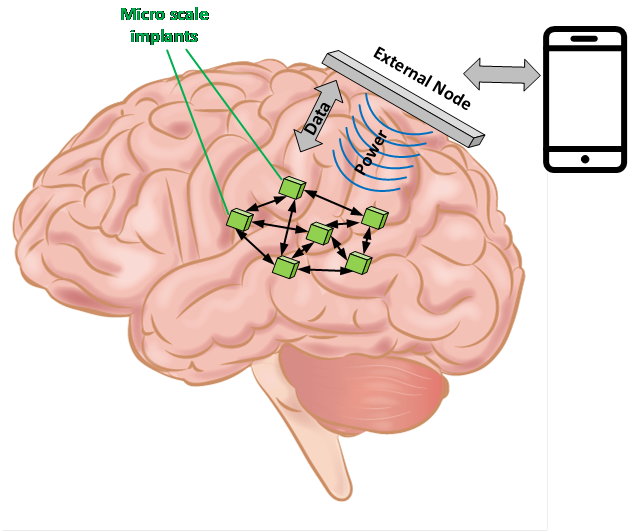MSc thesis project proposal
[2021] Body Coupled Communication for Microscale Implants
Massive and distributed neural recording/stimulation platforms have attracted a lot of interest during the past decade. The Neuralink, Neurograin, and Neural Dust projects are just a few of many well-known examples. One of the main objectives of such platforms is unlocking the mystery of neural network functionality. Despite all the advances in neuroscience and neural technology, there is yet no clear understanding of the central nervous system (CNS), in particular the interconnectivity of the various regions of the brain. Finding and exploiting the correlations between different neural activity in different regions of the CNS is an attractive example both for neuroscience and therapeutic applications. Prosthetic applications such as cortical visual prostheses and brain-controlled robotic arms are some other motivations for such platforms. Finally, there is an increasing interest in placing neural recording and stimulation sites far from each other for closed-loop neuromodulation systems with enhanced functionality and efficacy. High-density rigid electrode arrays cause more-than-required tissue damage for all the aforementioned applications, especially when a distributed/deep-in-tissue neural interface is required. Addressing this problem, Neuralink has proposed robotically assisted insertion of thousands of flexible electrodes with micro-scale thickness and 20-mm length. However, the system is still wired, and the electrodes are limited in the depths that they can reach. An alternative solution is the use of distributed injectable wireless micro-scale devices. This approach benefits from minimal tissue damage, extensive distribution capability, and wireless functionality. Therefore, this concept has attracted increasing research interests in different fields of science during the past decade. While most of the efforts have focused on powering these micro-scale implants, the networking of such devices is less addressed in the literature. The main challenge for this is the very constrained power and volume for implementing such a platform.
Body Coupled Communication (BCC) is an emerging approach for establishing connectivity between on/in-body devices. This method is exploiting body tissue as a communication medium between the devices. High data rate and low power consumption are among the most important advantages of this method. This project aims to investigate the applicability of the BCC method for a network of micro-scale implants. The project's main goal(s) is proposing and implementing a lightweight network protocol suitable for implantable micro-scale devices and/or implementation of an energy-efficient tissue interface for the BCC method.
Assignment
1. Literature review on body coupled communication and lightweight network implementations for biomedical applications.
2. Proposing a lightweight network protocol and/or energy-efficient tissue interface based on the BCC method.
3. Making a proof-of-concept benchtop prototype and validation of the proposed idea.
Requirements
The ideal candidate has the below attributes:
1. Curious and self-motivated;
3. Eager to do lab experiments and familiar with PCB design;
4. Knowledge about basics wireless network topologies and protocols is a plus.
Contact
dr. Amin Rashidi
Bioelectronics Group
Department of Microelectronics
Last modified: 2025-02-13
